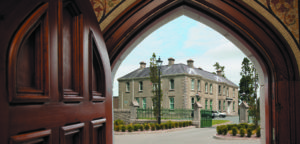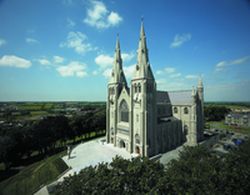RESPONDING TO RACISM CONFERENCE
SPONSORED BY THE IRISH COMMISSION FOR JUSTICE AND PEACE
GORT MHUIRE, DUBLIN
8 FEBRUARY, 2001
OPENING ADDRESS BY CARDINAL SEÁN BRADY
I welcome everybody to this Conference. I hope it will be a fruitful experience. The organisers intend it to be a contribution to the evolving response of the Catholic community in Ireland to the challenges of welcoming and living with people of different backgrounds, cultures, race and religion.
The purpose of the Conference is twofold. Firstly, it intends to deepen the reflections of the Catholic community in Ireland on the question of racism. Racism is a matter which touches the heart of our faith. Secondly, it is meant to help develop an appropriate answer to the question: How can we, how should we, respond concretely as a faith community to the racism which confronts us in our society? Yes, of course, words and denunciations are necessary. They are not enough, however. We have to develop a comprehensive pastoral response. Racism needs to be named as sinful wherever it occurs.
Some may ask why the title of the Conference emphasises the Catholic community in Ireland. Well, the reason is straightforward. It is simply to acknowledge the fact that we should look to our own house and examine our own conscience, as well as working with others in building a more inclusive society. As many of you already know there exists a strong body called the Churches’ Asylum Network. That Network meets regularly. It includes representatives of seven different Christian Churches in Ireland.
The Many Forms of Racism
Racism can take many forms. It is not true to say that there was no racism in Ireland prior to the arrival of refugees and asylum-seekers. It is salutary to realise how widespread racism is. Racism can be directed against members of the Travelling Community in our midst. In 1972 a travellers settlement committee, in a provincial town in Ireland, had this to say: “We who burn with righteous indignation at the lack of civil rights in the North blindly ignore the fact that in our own town nearly 200 Irish men and women and children are being denied their human and civil rights which are guaranteed and enshrined in our constitution under God. In our courts they are condemned to prison and to payment of exorbitant fines for offences of a comparatively minor nature while members of the settled community, coming from good homes, are treated with kid gloves”.
Racism can also be directed against Irish citizens whose skin colour is not white. It can take the form of anti-semitism. The Pontifical Council for Justice and Peace has noted a number of generic forms of racism in its examination of the question.
One form of racism is ethnocentricity. This has been defined as “a widespread attitude whereby a people has a natural tendency to defend its identity by denigrating that of others to the point that, at least symbolically, it refuses to recognise their full human quality”.
Another form of racism is the denial of minority rights. When these are not respected ethnic conflicts can take place. The new European Union Charter of Fundamental Rights addresses a broad range of civil, political, economic, social and cultural rights and seeks to protect people more effectively against discrimination, particularly racial discrimination.
The acknowledged weakness of the European Convention on Human Rights in respect of minorities eventually led to the formulation of the European Framework Convention on the Protection of National Minorities in 1994. This has been ratified in both jurisdictions in Ireland. Both the Irish and British Governments have ratified the UN Convention on the Elimination of Racial Discrimination.
The most important rights of members of minority communities under the Framework Convention are:
· to full and effective equality in all areas of economic, social, political and cultural life;
· to maintain and develop their culture and to preserve the essential elements of their identity, i.e. their religion, language, traditions and cultural heritage;
· to practise their religion and use their language;
· to be taught or educated in their distinctive language; and
· to participate effectively in public affairs, especially on matters affecting them.
Yet another form of racism is that of social racism within a country. “There is no great difference”, says the Pontifical Council, “between those who consider others their inferiors because of their race, and those who treat their fellow citizens as inferior by exploiting them as a work force”.
Spontaneous racism is another expression of racism. The analysis of the Pontifical Council of this form of racism is particularly pertinent to our current situation where we aggressively seek immigrant workers to help us maintain our high level of economic growth. It says:
“The prejudices which these immigrants frequently encounter, risk setting into motion reactions which can find their first manifestation in an exaggerated nationalism. This is a nationalism which goes beyond legitimate pride in one’s own country or even superficial chauvinism. Such reactions can degenerate into xenophobia or even racial hatred. These reprehensible attitudes have their origin in the irrational fear which the presence of others and confrontation with differences can often provoke.”
Finally, eugenic racism arises when people yield to the temptation to push the genetic manipulation of the human species to unethical lengths.
Responding in the light of the Bible and of Catholic Social Teaching
Once upon a time travellers were seen as a problem, a social problem. Of course the real social problem lies in the consequences of discrimination against travellers.
In the same way asylum-seekers and refugees are now seen as a “problem”. The real challenge is to see how the needs of asylum-seekers can be addressed alongside the needs of host communities. There is need to respect one another’s dignity rather than pitting people against the other. There is need to value our differences, as gifts that can enrich our lives. There is the need to be welcomed into one another’s lives. There is a need to be understood both in terms of language and in terms of the human heart. There is need for work and activity. There is need to accept that we have responsibilities on a global, not just on a national level.
The response of the Catholic Church is made in the light of the bible and of Catholic social teaching. All Christians hold dearly their conviction about the dignity of every human person and the unity of the human family. That conviction has come from biblical revelation as its main source. From the beginning the Christian community has reflected on this source. It did so in order to deepen and enrich its response to the challenge of contemporary life. It is important to keep doing so.
The first paper today, by Fr Kieran O’Mahony, OSA, is just such a reflection. It contains biblical insights into St Paul’s approach to communal inclusion. Fr O’Mahony is the author of “What the Bible says about the Stranger”, one of the titles in the Ecumenical Adult Study Guide series, What the Bible says about. This series is produced jointly by the Irish Council of Churches and the Irish Commission for Justice and Peace. It is yet another welcome sign of already well-established ecumenical endeavours in the response to the changing face of Ireland.
Catholic Social Teaching
The Church, of course, has in every age had to confront and dialogue with the society, with the cultures in which it lived and lives. So there has been a continuous interaction. The Church is simultaneously challenged by and challenging the values and experiences of different ages and different peoples. In recent centuries the response of the Church to many such issues has been stated in what we call Catholic social teaching. This is a very rich, organic, and it has to be said, often untidy growth, reflecting as it does the Church’s immersion in the daily business of living and of history. Rev. Dr Kevin Doran, in the second paper of the morning, will discuss the implications of the modern Catholic teaching on solidarity in a single human family for our response to racism. He will ask the question, how it can or should be further developed and applied to our evolving situation in this island? The Second Vatican Council expressed with great clarity and without any equivocation the elements of a considered Church judgement. It said, “Forms of social or cultural discrimination in basic personal rights on the grounds of sex, race, colour, social relation, language or religion must be curbed and eradicated and are incompatible with God’s design”.
The Task of Making Our Response Real
The second half of this day is given over to examining how the Catholic Church in Ireland can develop an increasingly effective and well-rooted pastoral response.
In his Message for World Day of Peace this year, Pope John Paul II issued a challenge to all of us. It is “to combine the welcome due to every human being, especially when in need, with a reckoning of what is necessary for both the local inhabitants and the new arrivals to live a dignified and peaceful life.” The rights of both the local inhabitants and of the new arrivals must be respected. Words must be accompanied by appropriate action.
The thrust of the afternoon session will be, hopefully, to generate the raw material from which an eventual Code of Good Practice regarding Racism will be developed for the Catholic Community.
Such a code would provide a checklist against which to assess our conduct, pastoral practice and institutional provision. Developing such a code may also, I suggest, act as an examination of conscience for us all.
Areas in which a Pastoral Response is indicated
The Church is challenged to develop its pastoral response in many areas. An appropriate response will be called for at parish level. Schools will be receiving children from many different backgrounds. Our catechesis will have to promote acceptance of difference, respect for the stranger and the practical demands of the Gospel in a multi-ethnic society. Differing liturgical traditions may have to be accommodated. I cite these merely as examples. No doubt the discussions will draw attention to others.
The Church has the sublime vocation of realising, first of all within itself, the unity of humankind. Racism in any of its forms is the negation of the community desired by Christ. Any ethnic, national, social or other divisions are now obsolete because they have been abolished by the Cross of Christ. This demand is stark and radical and asks a great deal of us as individual Christians and of the Church as an institution. If I were asked to summarise what response Catholics should make to those who differ from them in culture, race and tradition, I would say, firstly, they should actively welcome, secondly, listen and dialogue, thirdly, reflect and adapt where necessary in the light of the Gospel.
Let me end by quoting the Irish Times editorial of yesterday: “Our own experience as a people, which saw generations of poverty-stricken Irishmen and women forced abroad to make a living and to subsidise their families at home, should make us particularly sensitive to the needs and rights of asylum-seekers”.
Of course the Government has the right and the duty to protect the common good of its citizens.
Nevertheless they should be aware that asylum-seekers are experiencing various forms of exclusion. Under the direct provision benefit regulations asylum-seekers are in general not allowed to work (apart from those who came in a particular year) and are not entitled to employment training. State-funded language training is being introduced and this I warmly welcome.
One has to wonder – if the generations of Irish people forced to go abroad to make a living in the past had experienced similar exclusion – would they have made the contribution to the land of their adoption which we like to recall and of which we are so proud?
The Irish Times editorial says there is need to be generous to the dispossessed of the earth and to ensure that racism will not be tolerated. There are very many generous initiatives being conducted at present by religious orders and parishes throughout the country.
I am happy to recount a couple of initiatives which reflect the generosity required. One World Spirit is the name of a Dundalk refugee support initiative. It has established groups to offer services like computer training, counselling, English language training, legal advice to asylum-seekers and refugees. It intends to hold a social gathering on the last Saturday of each month and “Open Meetings” on the second Thursday of each month.
I was speaking recently to a Parish Priest who has a number of Russians and Ukrainians in his parish. Last month he organised a special welcome for them at the Sunday Liturgy. They were welcomed by name. Special places were reserved for them. They were greeted in their own language. They were invited to say a few words to the congregation. They were treated to a meal in a local restaurant. The response of the host community was warm, spontaneous and very generous.
I would encourage you today to listen carefully, and to contribute actively, so that others can benefit from your insights and experience. I know that the Commission for Justice and Peace together with the Bishops’ Refugee Project, the Council for Social Welfare and Trocaire, who are supporting this conference, intend to work up the input from the afternoon workshops into a draft Code of Good Practice for the Church. I look forward to the outcome, and wish God’s blessing on the day.


